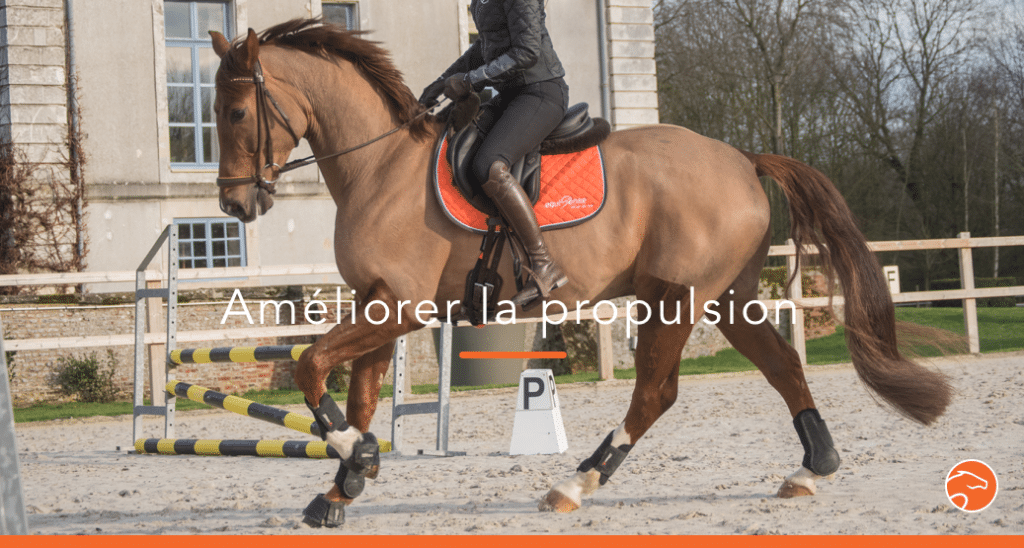How do you work on your horse’s extended trot ?
Contrary to the world of racing, we don’t want to work on the horse’s speed but on getting a stronger surge of power from behind and better amplitude of stride. You should therefore not change the cadence to go faster but cover more ground and show the extension of the horse’s gaits.
The trot is a two-beat symmetrical gait with a suspension phase, with the diagonal pairs of limbs moving in this sequence: left diagonal pair – suspension phase – right diagonal pair.
I recommend you do some work on two tracks. All lateral work, whether it is shoulder-in or leg-yielding, loosens not only the shoulders but also the haunches of the horse. It makes them more supple laterally, gives them more mobility and amplitude. And it helps them to extend their legs, be more supple and therefore improves the extended trot.
Alternate between shoulder-in and leg-yield. Then, once your horse is relaxed and supple, you can vary the pace and try to extend it a little in the lateral work. It will never be as beautiful as a proper extended trot on a straight line, but it’s always effective to give the horse mobility and especially to create a stronger push from his inside hind leg.
In your warm-up, even if you want to focus your session on extended trot, remember to canter as well. What is the reason for that? It’s because the canter is a pace that tends to be more comfortable for the horse’s back, that loosens and engages it more and creates more forwardness than the trot.
That’s why horses are always a little more forward and a little more active and supple in their gaits after cantering. It is a very good warm-up for the extended trot. Repeated canter / trot / canter transitions help as well: each time you get back into trot, you can see that the horse immediately has a better and slightly extended stride.
It is nevertheless important to note that this work on extended trot should be done over a very long period of time. It is the type of training that can take several years to bring results.
Next, I recommend using a set-up with a fan of poles in a corner of the arena. It will help to increase suspension and make your horse push harder to pick up his legs in the trot. Place six poles in a corner, five ‘pigeon steps’ apart (measuring with your feet). To make sure they are placed correctly, see how it goes the first time with your horse and adapt the distances accordingly. The important thing is to have a similar angle between all the poles, so the inside and outside ends of the poles must always be respectively at same distance from each other to make sure you have a regular fan shape.
Go in walk first to show the set up to your horse, so, by riding very tightly on the inside of the corner, where the space between the poles is the smallest. Once your horse is used to it, move closer to the outside of the corner, in trot this time. Remember to change reins regularly. Be careful not to approach it too fast: this is a gymnastics exercise and it also helps develop suspension, not speed!
This exercise will encourage your horse to step under with the hindlegs more. His trot will be more active. He will make the effort to place his feet according to the poles, and in fact, he will have better elevation to his steps.
You can also use this set-up when lunging, because it is a very good gymnastics exercise for your horse’s trot.
That’s it, now you can start to develop and extend the trot. In working trot, the horse’s hind hoof prints contact the front hoof prints. In extended trot, you aim to reach beyond the front hoof prints. And the more you do, the better the extended trot is. But remember, it is a test of strength and suppleness, not of speed!
During your extended trot sessions, let your horse lower his neck to stretch if he asks for it. This exercise requires a lot of effort from them; extended gaits use up a lot of energy. And remember that it is mostly the transitions that will give the strength and propulsion that you are looking for. You will certainly not improve your extended trot by only working on extending the gait!
The quality of the work is highlighted by the ground pole work and the transitions. Indeed, constantly changing your horse’s balance allows you to transfer weight onto his hindquarters, which makes him stronger and allows him to propel himself forward more.
Do you have difficulty working on your horse’s extended trot ? What do you think of this email ? Leave me a comment here.

